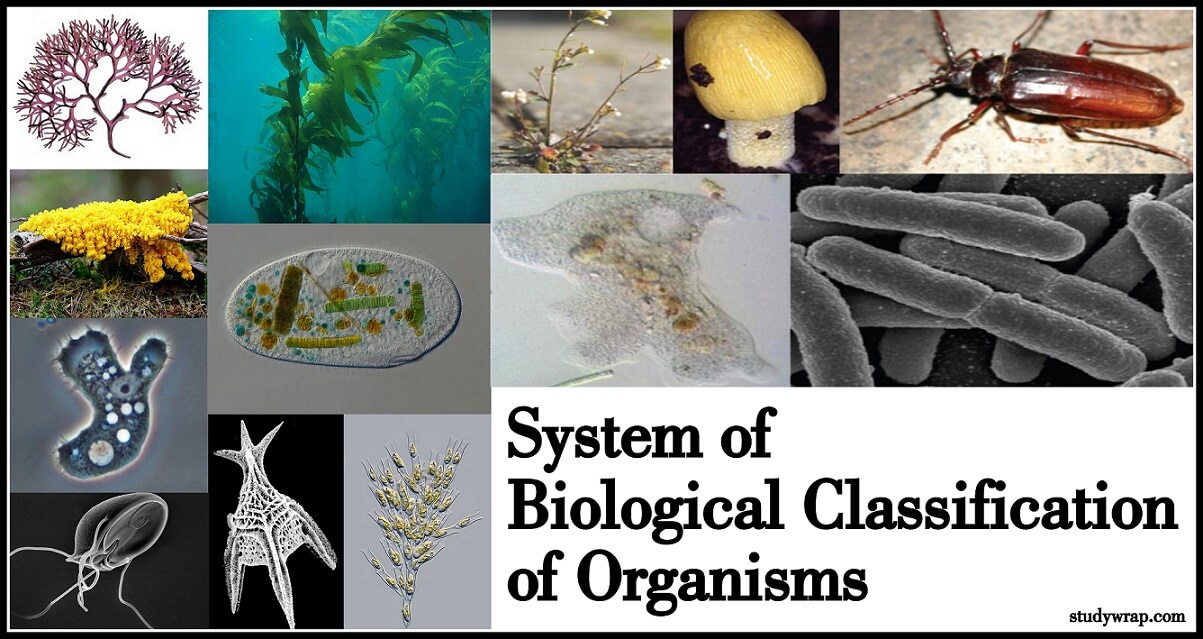Science
Biological Classification of Organisms
Biological Classification
Table of Contents
- Biological classification is the scientific way of orderly arrangement of organisms into hierarchical series of groups and sub groups on the basis of their similarities and differences in certain easily observable but important characters.
Need For Classification of Living Organisms
- The study of one or two organisms is not sufficient to know the essential features of the group.
- All kinds of organisms do not occur in one locality.
- It helps in knowing the relationship between the different groups of organisms.
- It helps in knowing the evolutionary relationship between organisms.

Systems of Classification
- The history of biological classification began with Aristotle, the Greek philosopher, who is often called the father of biological classification. He described animal classification based on their habitat, i.e., air, water and land.
- However later with development in science, taxonomist used various other basis of classification like natural affinity, and even phylogeny (evolutionary tendencies).
- The systems were divided into three major categories. They are as follows:
-
- Artificial,
- Natural And
- Phylogenetic Systems
-
Artificial System of Classification
- Based on one or few external or morphological characters of organisms, which may not have any phylogenetic significance. Artificial system of classification often results in placing of unrelated organisms in a group.
- For Example –
- Aristotle classified animals as enaima and anaima, on the basis of the presence or absence of red coloured blood.
- Linnaeus’ system of classification (based on sexual characters and also termed sexual system of classification) is also an artificial system of classification.
Drawback
-
-
- Characters of organisms considered were limited and led to few divisions for classification.
- This system failed to consider the phylogenetic relationships between the organisms.
- The genetic traits used were not the constant, but the variable one that changed according to the environment.
-
Natural System of Classification
- These classification systems were based on the taxonomic characters and on natural similarities of the organisms.
- A natural system of classification is based on the overall reproductive, morphological and anatomical characteristics, which specify natural relationships among organisms.
- Initially, it used overall morphological similarity, but gradually it got refined to use anatomy, embryology, ultrastructure, etc. fields of study but not the evolutionary evidences.
- Natural systems of classification provide little chance of placing of unrelated organisms in a group.
- For Example –
- de Jussieu (1699 – 1776) divided the flowering plants into groups on the basis of monocots, dicots, ovary positions, presence or absence of petals, etc.
- George Bentham and D. Hooker (1862-1883) gave the most important natural system of classification of angiosperms, published in their treatise Genera Plantarum.
Drawback
-
-
- Artificial and natural system of classification were dependent on fixed number of organisms and no new species were included. Thus, they are the static classification systems with no change in them.
-
Phylogenetic System of Classification
- The system classifies organisms on evolutionary and genetic relationship between them. In this system, organisms belonging to the same taxa are believed to have common ancestry and may be represented in a family tree called cladogram.
- First phylogenetic system of classification of the entire plant Kingdom was jointly proposed by Adolph Engler(1844-1930) and Karl A Prantl (1849-1893). They published their classification in a monumental work “Die Naturelichen Pflanzen Familien” in 23 volumes (1887- 1915). They considered polyphyletic origin of angiosperms from a hypothetical gymnospermic ancestor.
- John Hutchinson, gave his phylogenetic system of classification in two volumes of the book ‘The Families of Flowering Plants’. Hutchinson described monophyletic origin of angiosperms.
- Chances of placing unrelated organisms in a group are negligible.
Phenetic System for Classification
- It is a form of numerical systematics in which organisms are grouped based upon the total or relative number of shared characteristics.
- It makes the use of overall similarity in terms of phenetic relationship based on data from all available sources such as morphology, anatomy, embryology, phytochemistry, etc.
- Phenetic classification were strongly advocated by Sneath and Sokal (1973).
- This system of biological Classification was done by the following taxonomies –
1. Cytotaxonomy
-
-
- It provides cytological information of cell, the chromosome number, the structure etc. It also involves the behaviour and expression of chromosomes during classification.
- Classification based on comparative cytological studies, number of chromosomes, structure and meiotic behaviour of chromosomes.
-
2. Chemotaxonomy
-
-
- This type of taxonomy utilizes the chemical constituents of plants. Such characters like fragrance and taste are stable i.e.do not change easily.
- Classification based on characteristics of various chemical constituents of organisms like amino acids, proteins, DNA sequences, alkaloids, etc.
-
3. Numerical taxonomy
-
-
- It evaluates resemblances and differences by statistical methods based on a large number of characters obtained from all disciplines of biology.
- Based on the numerical technique for evolution that included both similarities and differences between the species.
-
4. Cladistic taxonomy (Cladistics)
-
-
- It classifies living being into evolutionary historical order in which the branches of organism arose.
- Arrangement of organisms on the basis of their shared similar or derived characters that differ from ancestral characters will produce a phylogenetic tree called cladogram.
-
So this was all about the Biological Classification of the Organisms. If you like the post do share with your friends and like our Facebook page for regular updates. For Other Biology Notes Click Here.

